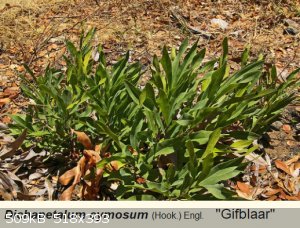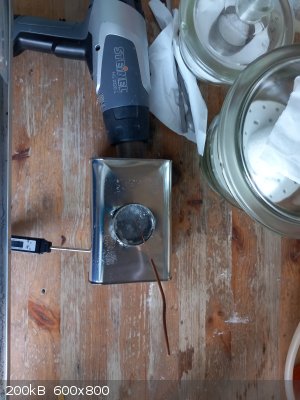| Pages:
1
2 |
dicyanin
Hazard to Self
 
Posts: 57
Registered: 29-3-2020
Location: Europe
Member Is Offline
Mood: inquisitive
|
|
Africa Seeds carries it, but it's really expensive for what is essentially a native weed, $35 for 8 seeds. Monofluoroacetate is toxic to humans, but
other mammals are much more sensitive to it. Attached paper discusses its properties and the preparation of some derivatives.
They also prepare monofluoroacetic acid by refluxing methyl monoiodoacetate with silver fluoride at 170°C in a platinum apparatus , followed by saponification of the ester. Apparently when a platinum refluxing
apparatus is not available, the authors note a lead one can be used. , followed by saponification of the ester. Apparently when a platinum refluxing
apparatus is not available, the authors note a lead one can be used.

Attachment: MONOFLUOROACETIC ACID the toxic principle of Gifblaar (Dichapetalum cymosum) _marais1944_20_1.pdf (664kB)
This file has been downloaded 56 times
sic transit gloria mundi
|
|
|
sceptic
Harmless

Posts: 49
Registered: 7-6-2022
Location: Southern Africa
Member Is Offline
|
|
After reading this thread, I'm in no hurry to do so, but if I wanted to extract fluorine compounds from gifblaar, does anyone know of a reasonably
safe way to do it? I ask because here (southern Africa) I have an almost unlimited supply of that plant available.
|
|
|
Texium
Administrator
       
Posts: 4516
Registered: 11-1-2014
Location: Salt Lake City
Member Is Offline
Mood: PhD candidate!
|
|
I found the previous paper published by the author of the one above. I wasn't able to access the full text, but fortunately the relevant portion was
available:
| Quote: | | Extract 10 kg. dried and finely ground plant material with 96% EtOH for 36-48 hrs., distil the alc. under reduced pressure, dissolve the sirupy mass
in 4 l. water, add 500 cc. 10% H2SO4 and let stand for 1-2 days to allow precipitated material to settle. Filter the solution by suction, extract the
filtrate repeatedly with Et2O, neutralize the combined extracts to phenolphthalein with N KOH and sep. the aqueous solution which contains the K
cymonate. Evaporate the solution to about 300 cc. on the water bath, liberate the free acid by adding the equivalent amount of dilute H2SO4, and
repeatedly extract the solution with Et2O until practically all the acid is removed. Decolorize the Et2O extract with activated charcoal, dry
overnight with anhydrous Na2SO4, filter and distil the Et2O at low temperature Transfer the concentrate to a small distillation flask, collect the
distillate in fractions of 10° up to 160°, carefully neutralize (N KOH and phenolphthalein) the individual fractions, as well as the initial Et2O
distillate, and evaporate the K salt solutions separately to dryness on a water bath. Wash the residues with acetone, dry at 100° and crystallize
from 96% EtOH. The best yields of the K salt are obtained from the 110-160°, fractions. After repeated recrystallization from 96% alc. the salt melts
at 213° with decomposition; insoluble in anhydrous organic solvents except MeOH. |
J. S. C. Marais,
Onderstepoort Journal of Veterinary Research, Volume 18, Pages 203-206, 1943
Apparently before they figured out it was monofluoroacetate, they called the mystery anion "cymonate."
|
|
|
teodor
National Hazard
   
Posts: 872
Registered: 28-6-2019
Location: Heerenveen
Member Is Offline
|
|
This is molten NH4F inside my DIY home fume hood.
And I am still alive. So, the answer: it depends ...
When I did planning to start playing with F I've selected boron trifluoride and BF4 anion as an entry level but still very interesting F compound.

|
|
|
ItalianChemist
Hazard to Others
  
Posts: 172
Registered: 26-1-2011
Location: Italy
Member Is Offline
Mood: No Mood
|
|
BF4 anion is very interesting in coordination chemistry since it forms many compounds that can be easily crystallized from water.
Also I don't think it is very dangerous unless it is heated. (It will release some amounts of HF I suppose)
|
|
|
teodor
National Hazard
   
Posts: 872
Registered: 28-6-2019
Location: Heerenveen
Member Is Offline
|
|
NH4BF4 is quite volatile. I kept it in an open container for drying and it covered inside walls of my cabinet.
I plan to use it for generate BF3 which have many interesting applications in inorganic as well as in organic chemistry. Also it's very potent drying
agent.
[Edited on 21-2-2024 by teodor]
|
|
|
EF2000
Hazard to Others
  
Posts: 109
Registered: 10-5-2023
Location: The Steppes, now trapped in the forest zone
Member Is Offline
Mood: wrooom
|
|
Quote: Originally posted by Texium  | I found the previous paper published by the author of the one above. I wasn't able to access the full text, but fortunately the relevant portion was
available:
J. S. C. Marais, Onderstepoort Journal of Veterinary Research, Volume 18, Pages 203-206, 1943
Apparently before they figured out it was monofluoroacetate, they called the mystery anion "cymonate." |
Here's the paper, found it in open access on the University of Pretoria website: https://repository.up.ac.za/handle/2263/59331
Attachment: 19marais1943_18.pdf (279kB)
This file has been downloaded 53 times
Wroom wroom
|
|
|
mr_bovinejony
Hazard to Others
  
Posts: 123
Registered: 20-4-2018
Member Is Offline
Mood: ASS
|
|
Quote: Originally posted by teodor  | NH4BF4 is quite volatile. I kept it in an open container for drying and it covered inside walls of my cabinet.
I plan to use it for generate BF3 which have many interesting applications in inorganic as well as in organic chemistry. Also it's very potent drying
agent.
[Edited on 21-2-2024 by teodor] |
Sodium tetrafluoroborate can be used as well for this, does NH4BF4 work better? I'd like to make trifluoroacetic acid but I have found no other way
than to use antimony fluoride compounds.
|
|
|
EF2000
Hazard to Others
  
Posts: 109
Registered: 10-5-2023
Location: The Steppes, now trapped in the forest zone
Member Is Offline
Mood: wrooom
|
|
Gastrolobium calycinum is ~5 AU dollars for packet from Australian Seed: https://www.australianseed.com/shop/item/gastrolobium-calyci...
Gastrolobium bilobum is 6.5 USD for 10 seeds from rarepalmseeds.com, even though it's not rare and not a palm. And $14 for 1,000 seeds, meaning that for the price of 8 giftblaar seeds one can get
~2,500 poison brush seeds and plant an entire garden with it. Very toxic garden.
I also found a little instruction how to pre-treat seeds and sow them.
Attachment: Gastrolobium species.pdf (339kB)
This file has been downloaded 45 times
Wroom wroom
|
|
|
Rainwater
National Hazard
   
Posts: 800
Registered: 22-12-2021
Member Is Offline
Mood: indisposition to activity
|
|
Side note, he is some dude spraying cold fluorine gas onto a fire brick (time index 11:12)
https://youtu.be/KX-0Xw6kkrc?t=672
"You can't do that" - challenge accepted
|
|
|
Dr.Bob
International Hazard
    
Posts: 2660
Registered: 26-1-2011
Location: USA - NC
Member Is Offline
Mood: No Mood
|
|
I did work in a fluorochemical synthesis lab for a few years with my old friend Ed, who was much more jaded about working with fluorine than most
people are today, having worked with it for 50+ years. But only long after working there did I realize how many things he had there were incredibly
toxic, like cylinders of F2, HF, SF4, and many others, plus some other things like monofluoroacetic acid and related compounds. But he was somehow
lucky, and I think the F2 just made him inert to all other chemicals, as he lived to be about 98.
But even Ed had Calcium Gluconate kits and other safety gear, plus some very large scrubbers which most of the gas streams went out through. Mostly
I worked with Freons, which are quite safe to handle, but the process of fluorinating hydrocarbons is quite exciting, and involves some very
specialized equipment.
I have also used anhydrous liquid HF for cleaving and deprotecting peptides, which is mostly not done any more now (mostly used for tBoc type peptide
chemisty, which is rarer now). That was almost as crazy, but done in special hood with special equipment, and 2 thick gloves, special aprons, face
mask, etc. That was just as nuts, and done in big pharma lab. I would not do it for fun or much else now. But I have done other fluorine type
chemistry that is safer and many fluoro groups are fine, like many, but not all, -CF3 type reagents. So the safety is quite dependent on the exact
type of chemistry, the equipment, and the real need to do it. Like making some fluorophosphates, minor changes can make drastic differences in
toxicity.
So I would say that some fluorine chemistry is quite safe, some is dangerous, and some is nuts. Even Ed tried to use ClF3 a few times and decided
that it was not able to be used safely for anything, depsite being a very powerful fluorinating agent.
[Edited on 26-3-2024 by Dr.Bob]
|
|
|
BromicAcid
International Hazard
    
Posts: 3227
Registered: 13-7-2003
Location: Wisconsin
Member Is Offline
Mood: Rock n' Roll
|
|
Had a very nasty experience with SF4 at one point Dr.Bob, always interesting to see people mention it since it tends to fly under the radar of most
chemistry.
|
|
|
| Pages:
1
2 |